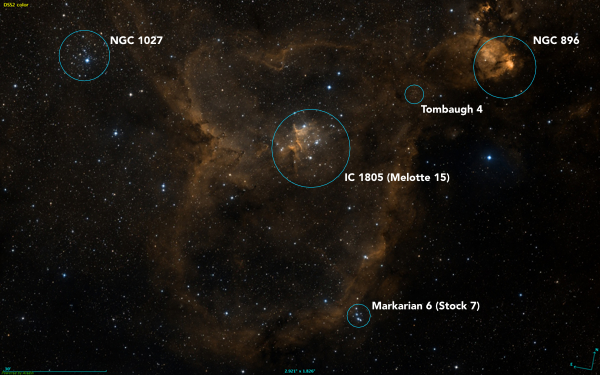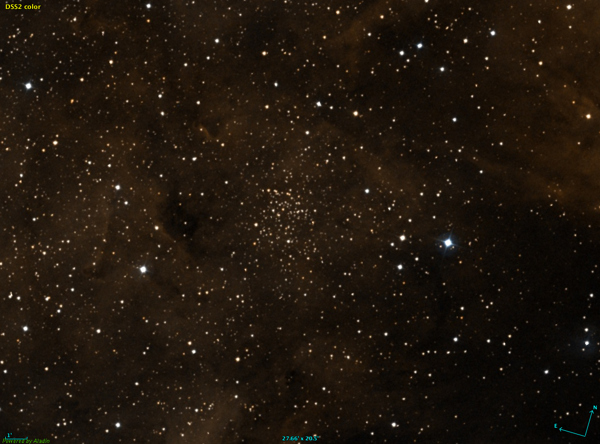Around the Heart Nebula (IC 1805) in Cassiopeia
November 2020 - Nebula and Cluster of the Month
This month, we’ll be looking at a compact region of sky in Cassiopeia to inspect four open clusters all wreathed in the same nebulosity, and then we’ll move south to Fornax with an interesting object for more southern observers.

IC 1805 is a large and spectacular region of emission nebulosity beloved of imagers. This is understandable. It’s high in the sky for northern observers and presents a wealth of structure and detail. The area covered by the nebula (about 3° x 3°) contains many differently-labelled nebulae and at least four open clusters. Each little knot of the nebula seems to have its own catalogue number, but for the purposes of this discussion, I’ll assume that ‘IC 1805’ refers to the whole lot.
IC 1805 was discovered by E. E. Barnard. The designation refers to both the nebulosity and the central open cluster. The description in the Index Catalogue reads Cluster, coarse, extremely large nebulosity extends following.
Having said Barnard was the discoverer, the brightest portion of the nebula, on its western edge, which bears the designation NGC 896, was discovered over a century earlier, predictably by William Herschel, on 3 November 1787, when he described it as Extremely faint, small, irregularly formed
. My own observation of NGC 896, the only part of the nebulosity that I find clear enough actually to draw, reads A small amount of nebulosity around a faint star, with a slightly brighter patch to the west. Formless and of uniform surface brightness.

At the centre of the nebulosity is the open cluster also designated IC 1805, though sometimes referred to as Melotte 15. This is a large, bright, loose, splashy cluster. It contains several fairly bright stars. About 30-35 stars are easily visible in a 20' field. With a UHC filter in place, faint nebulosity can be seen across much of the field.
Just about 1° following this cluster is another, NGC 1027, which lies right on the edge of the IC 1805 nebulosity. I observed this cluster through a 12” (305mm) Newtonian and found it to be A fairly loose cluster of mixed magnitude stars. The brightest, at the centre, is magnitude 7.0, though it's so much brighter than the others that it may be foreground. Some stars at around 9th - 10th magnitude, more at around 13th magnitude.
Later reading showed that my assumption about the bright central star (SAO 12402, HD 16626) to be correct, it is a foreground object, coincidentally almost dead-centre of the cluster.
Although apparently involved in the IC 1805 nebula, NGC 1027 actually lies much closer to us. The distance to 1027 is about 4000 light-years, whilst the nebula is about 7200 light-years away.
In February 1980, a team of astronomers led by Helmut Abt of Kitt Peak Observatory published a paper in the ‘Publications of the Astronomical Society of the Pacific’ entitled ‘A Small Cluster Near IC 1805’. The paper describes an investigation into a ‘small cluster’ apparently located within the IC 1805 nebula. Although the cluster is not named at any point in the paper, it is clear that it is the bright but poor little group known as both Markarian 6 and Stock 7.

Abt’s team set out to investigate whether this was a true cluster, and whether or not it was physically associated with IC 1805. They concluded that it was a true cluster consisting of at least four members, the two brightest of which were shell stars (rapid rotators like γ Cas and Pleione in the Pleiades). Fainter stars in the field may not be truly associated with the group. The distance they measured was 485 pc (1580 ly), placing it well in the foreground of IC 1805. A more recent measure of the distance places it slightly further away at 511 pc (1660 ly). The entry for Markarian 6 in Archinal & Hynes ‘Star Clusters’ gives the number of member stars as 29.
Visually, this is a pleasing little group, looking like a bent cross, or a slightly disjointed version of Delphinus. A good night will show 30–35 stars in a 20’ field, though the probability that all, or most, of these stars are true members must be considered remote.
Our last port of call within this nebula is another open cluster, Tombaugh 4, which lies 24’ to the south-east of NGC 896, the brightest portion of our nebula. Tombaugh 4 is a very different beast from the other clusters we’ve looked at. Firstly, it is very faint, with the brightest members just about topping 16th magnitude. Secondly, it is very rich, though Archinal & Hynes credit it with only 40 members. Images of the cluster seem, to my eyes at least, to show far more stars than this. One for the 20”+ brigade, I think.

This is a wonderful area to explore. It’s compact, just 3° across, yet it’s filled with good objects and given a good sky and a UHC filter, faint nebulosity can be seen stretching across much of it.
Now to move south to the constellation of Fornax. Our object here is a tiny thing, NGC 1049. This very small object (visually less than 1’ in diameter) was discovered on 19 October 1835 by John Herschel, whose description in his ‘Cape Observations’ reads: Pretty bright, small, round, like a star 12m a very little rubbed at the edges, a curious little object and easily mistaken for a star, which, however, it certainly is not.

He was quite right, of course. NGC 1049 is a globular cluster, but not one that belongs to the Milky Way. 102 years after Herschel discovered NGC 1049, Harlow Shapley discovered the galaxy now known as ESO 356-4, PGC/LEDA 10074 or, more commonly, the Fornax Dwarf. The Fornax Dwarf is a spheroidal galaxy, a satellite to our own. It currently has six known globular clusters, of which NGC 1049 is the brightest. The galaxy itself has a combined magnitude of 9, though as this is spread over about one square degree (four times the size of the full moon), it is exceptionally dim. NGC 1049 is superimposed on the face of the galaxy.
The globular cluster, although very small, shines at magnitude 12.6, and as it is sort-of stellar, it should make for a relatively easy target for observers far enough south to see it.
One aspect of visual observing is the drive to see further, fainter. Seeing globular clusters in external galaxies is one way of doing this. Stretch yourself. NGC 1049 is an easy place to start.
| Object | RA | Dec | Type | Magnitude |
|---|---|---|---|---|
| NGC 896 | 02h 25m 31s | +62° 00’ 54” | Emission nebula | |
| Tom 4 | 02h 28m 51s | +61° 46’ 35” | Open cluster | Br * = 16.0 |
| Mk 6 | 02h 29m 42s | +60° 40’ 23” | Open cluster | 7.1 |
| IC 1805 | 02h 32m 41s | +61° 27’ 17” | Open cluster + emission nebula | 6.5 (cluster) |
| NGC 1027 | 02h 42m 37s | +61° 35’ 19” | Open cluster | 6.7 |
| NGC 1049 | 02h 39m 48s | -34° 15’ 47” | Globular cluster | 12.6 |